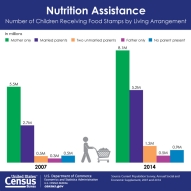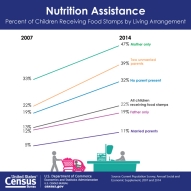For Immediate Release: Friday, February 20, 2015
One in Five Children Receive Food Stamps, Census Bureau Reports
News Release Correction
The U.S. Census Bureau has corrected a statistic published in the news release for the 2014 America’s Families and Living Arrangements table package. The news release, posted on Jan. 28, 2015, included the following bullet, which erroneously double-counted children living with two foreign-born parents:
- 38 percent have at least one foreign-born parent (28.3 million).
The corrected bullet states:
- 24 percent of children live with at least one foreign-born parent (18.1 million).
One in Five Children Receive Food Stamps, Census Bureau Reports
Originally released: January 28, 2015
The number of children receiving food stamps remains higher than it was before the start of the Great Recession in 2007, according to the U.S. Census Bureau’s annual Families and Living Arrangements table package released today.
The rate of children living with married parents who receive food stamps has doubled since 2007. In 2014, an estimated 16 million children, or about one in five, received food stamp assistance compared with the roughly 9 million children, or one in eight, that received this form of assistance prior to the recession.
These statistics come from the 2014 Current Population Survey’s Annual Social and Economic Supplement, which has collected statistics on families and living arrangements for more than 60 years. Today’s table package delves into the characteristics of households, including the marital status of the householders and their relationship to the children residing in the household. The historical data on America’s families and living arrangements can be found on census.gov.
Other highlights:
Children
- Of the 73.7 million children under 18 in the United States:
- 10 percent live with a grandparent (7.4 million).
- 79 percent live with at least one sibling (58.5 million).
- 15 percent have a stay-at-home mother (10.8 million), and 0.6 percent have a stay-at-home father (420,000).
- 24 percent of children live with at least one foreign-born parent (18.1 million).
- The share of children who live with one parent only has tripled since 1960, from about 9 percent to 27 percent.
Marriage and family
- Less than half (48 percent) of households today are married couples, down from 76 percent in 1940.
- The median age when adults first marry continues to rise. In 2014, it was 29 for men and 27 for women, up from 24 and 21, respectively, in 1947.
- 36 percent of 30- to 34-year-olds have never been married.
- Married couples have more children in the household, on average, than either single mothers or single fathers.
- Married couples make up the majority (72 percent) of the 86.4 million family groups, which are defined as two or more people who live together and are related by birth, marriage or adoption. Unmarried mothers and unmarried fathers make up 12 percent and 2 percent of family groups, respectively.
- 24 percent of married families with children under 15 have a stay-at-home mother, and 1 percent have a stay-at-home father.
Unmarried couples
- 7.9 million opposite-sex unmarried couples live together.
- 39 percent of opposite-sex unmarried couples have a child under 18.
- Statistics about same-sex couples are available from the American Community Survey.
Older adults
- There are about 13 million more householders 65 or older than there are householders under age 30. In 1960, the difference was just 2.5 million.
- One quarter of all adults 65 or older are widowed; fewer than 5 percent have never been married.
- About 12.5 million older adults live alone, representing 28 percent of adults 65 or older.
Households
- The share of single-person households has more than doubled since 1960, from 13 percent to 28 percent (34.2 million households) today.
- More than two-thirds (69 percent) of white households own their home, compared with less than half of black (43 percent) or Hispanic (46 percent) households.











